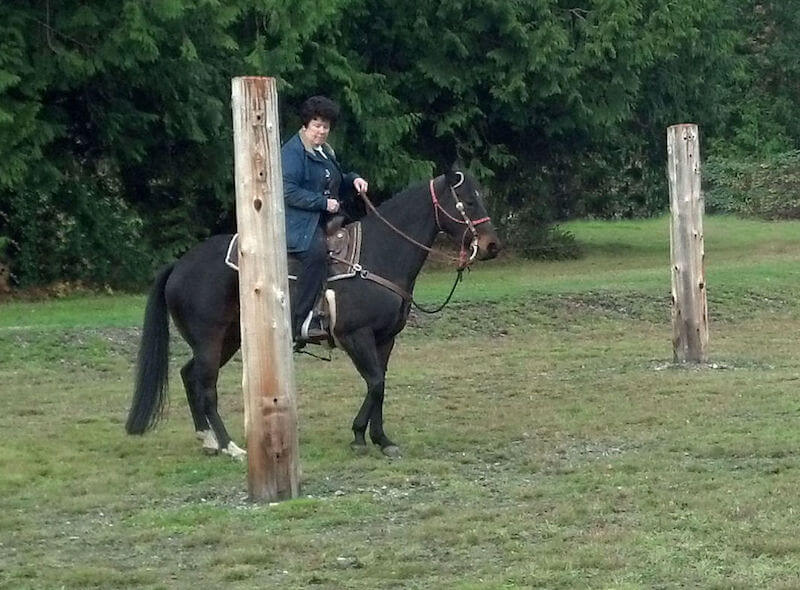Tips for Backing a Smooth Circle
by Marilyn Pineda
A couple of gals recently brought their horses to the trail course at Fire Mountain. Bonnie had been here previously as a participant in the Obstacle Challenge Play Day we held in October, but was still interested in listening in with Kathryn on some of the basic information we cover during orientation for new visitors.
In addition to discussing the difference between leading and sending horses, I touched on the necessity of being able to ask the horse to yield both its front and hind quarters. In order for the horse to be able to successfully yield, it is essential for the handler/rider to use only the amount of pressure absolutely necessary, as well as exercise patience while waiting for the horse’s correct response. An example of this handler responsibility surfaced while discussing how to ask a horse to yield the front quarters while backing in a nice, symmetric circle. Bonnie shared that this particular backing challenge provided her with an “Aha!” moment of revelation during her previous visit to the trail course, and was one of the things she wanted to follow up on with more practice while she was here with Kathryn.

For many riders, backing in a circle is one of the more difficult maneuvers to perform well, but the components involved can easily be taken from tools that have been practiced with your horse from the ground. To make this challenge more fluid, the first thing to realize is that backing on an obstacle should be done at a steady pace, practiced on the ground by rhythmic pressure from the front of the horse. This rhythm must match the movement of each front foot and is requested with as little pressure as possible from the lead rope, which will transfer to the reins from the saddle later on. Yes, signals from the legs are the primary aid from the saddle with the same rhythmic pressure placed towards the front of the girth area, but the secondary aids come from the reins. The reins are not able to be used efficiently unless they are learned properly. This is why using loose lead ropes during ground exercises is so important.
The next component is the “steering” mechanism, which needs to be done from the front quarters. It is best to practice backing in a straight line before attempting circles, then move into circles and serpentine curves. Practice by asking your horse to move his front quarters away from pressure using as little pressure as possible. In addition, move your horse’s front quarters in varying degrees as you back him (from slight shifts to complete front leg cross-overs) working from the front and on both sides of the head and neck area. When you bring this exercise to the saddle, you will be able to use leg cues in varying degrees to control the front quarters of the horse for the precise amount of directional variance you desire in the moment, all while maintaining a relaxed, comfortable manner.
Another backing tip involves the use of your peripheral vision to visualize where you want to go rather than twisting around to look over your shoulder. It is fine to glance back as needed for occasional references, but you should try to keep your seat balanced by sitting straight, looking up and facing forward, as your horse is backing.
Finally, remember that on obstacle challenges there is no need for speed when backing. In fact, the faster you try to go the more correction you will likely end up needing if you fall out of the symmetric circle you are trying to create.
Think on things one step at a time, at a nice steady pace, and you will be on your way to backing well grounded!
Published January 2014 Issue

The Colorado Horse Source is an independently owned and operated print and online magazine for horse owners and enthusiasts of all breeds and disciplines in Colorado and surrounding area. Our contemporary editorial columns are predominantly written by experts in the region, covering the care, training, keeping and enjoyment of horses, with an eye to the specific concerns in our region.

